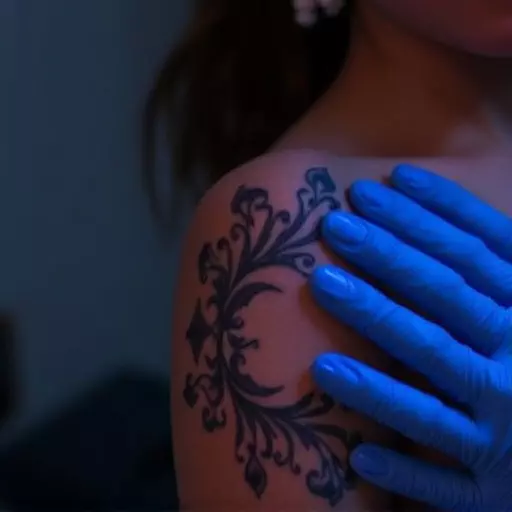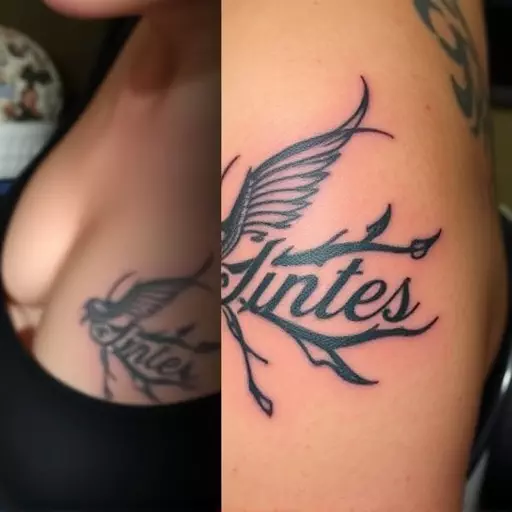In Toledo, individuals can choose between laser and non-laser methods for tattoo lightening. Laser tattoo lightening uses targeted beams to fragment ink, while non-laser techniques like topical creams or chemical treatments stimulate skin healing. Non-laser methods, including Toledo, offer gentler alternatives but may take longer; results vary based on tattoo age, size, and color. Effective post-treatment care is crucial for both types, involving cleaning, moisturizing, sun protection, and avoiding direct sunlight/chlorinated pools. Side effects include redness, swelling, and itching, manageable through proper aftercare. Healing times range from 2-3 weeks to several months, with non-laser methods recovering slightly faster. Preventing complications includes sun protection, high-SPF sunscreen, proper cleansing, hydration, and a vitamin-rich diet for optimal results.
Tattoo lightening has emerged as a popular method to reduce or eliminate unwanted ink. This comprehensive guide delves into various aspects of this procedure, from understanding the tattoo lightening process using techniques like Toledo and laser methods, to exploring non-laser alternatives. We break down essential aftercare tips, manage common side effects, outline healing timelines, and provide safety measures to prevent complications. Whether you’re considering laser tattoo lightening or non-laser tattoo lightening, this article offers valuable insights for optimal results.
- Understanding Tattoo Lightening: A Comprehensive Overview
- The Tattoo Lightening Process: Toledo vs Laser Techniques
- Non-Laser Methods for Tattoo Lightening: Alternatives to Consider
- Post-Treatment Care: Essential Aftercare Tips for Tattoo Lightening
- Common Side Effects and How to Manage Them
- Healing Timeline: What to Expect After Tattoo Lightening
- Preventing Complications: Safety Measures for Optimal Results
Understanding Tattoo Lightening: A Comprehensive Overview

Tattoo lightening is a popular procedure for those looking to change or reduce the appearance of existing tattoos. The process involves breaking down and fragmenting the pigment in the tattoo ink, allowing it to be absorbed by the body’s natural processes. In Toledo, as well as globally, both laser and non-laser tattoo lightening methods are available, catering to diverse preferences and needs.
Laser tattoo lightening uses targeted beams of light to break up the ink particles, making them smaller and easier for the immune system to eliminate over time. This method is effective but requires multiple sessions, depending on the size, color, and depth of the tattoo. On the other hand, non-laser tattoo lightening techniques, such as topical creams or chemical treatments, offer an alternative approach. These methods aim to gradually fade the tattoo by stimulating the skin’s natural healing process, though results may vary and can take significantly longer.
The Tattoo Lightening Process: Toledo vs Laser Techniques

The tattoo lightening process involves techniques that go beyond simple fading. Two prominent methods stand out: Toledo and laser tattoo lightening. Non-laser tattoo lightening techniques, like Toledo, have gained popularity due to their ability to target specific ink colors without damaging the skin. This method uses specialized chemicals and light to break down pigment particles, making them easier for the body to absorb and eliminate over time.
On the other hand, laser tattoo lightening is a more traditional approach that employs high-intensity beams of light to fragment ink particles. Lasers offer precise targeting of specific colors, making them effective for removing unwanted tattoos. However, they can be more aggressive on the skin, potentially causing side effects like scarring and prolonged healing periods. Choosing between these methods depends on individual preferences, budget, and the desired outcome, with non-laser techniques offering a gentler alternative for tattoo lightening.
Non-Laser Methods for Tattoo Lightening: Alternatives to Consider

Non-Laser Methods for Tattoo Lightening offer a range of alternatives for those looking to lighten or remove tattoos without the use of intense laser technology. One popular option is chemical tattoo lightening, where specific chemicals are applied topically to break down the pigment in the tattoo. This process can be effective but requires careful application and adherence to aftercare instructions to prevent skin irritation or adverse reactions.
Another non-laser approach involves using at-home devices like microdermabrasion tools or topical creams that claim to fade tattoos. While these methods are more accessible and potentially less costly, their results may vary greatly depending on the tattoo’s age, size, and color. It’s crucial for individuals considering non-laser tattoo lightening to research extensively and consult with professionals who can guide them through the process and set realistic expectations.
Post-Treatment Care: Essential Aftercare Tips for Tattoo Lightening

Post-treatment care is an integral part of the tattoo lightening process, whether in Toledo or beyond. After your laser or non-laser tattoo lightening session, it’s crucial to follow specific aftercare tips to ensure optimal results and minimize potential complications. For laser tattoo lightening, keeping the treated area clean and moisturized is paramount. Avoid touching or scratching the skin, as this can introduce bacteria and delay healing. Use gentle, fragrance-free soaps and apply a thin layer of unscented moisturizer daily.
Non-laser methods may require slightly different care. In general, avoid exposing the lightened tattoo to direct sunlight without protection. Wear long sleeves and hats when outdoors to prevent further darkening or fading. Avoid swimming in chlorinated pools or hot tubs for at least a week after treatment as chlorine can irritate the skin. Lastly, be patient during the healing process, as it may take several weeks for your skin to fully recover and the tattoo’s color to stabilize.
Common Side Effects and How to Manage Them

After undergoing tattoo lightening procedures, whether laser or non-laser based, individuals may experience several common side effects. These can include redness, swelling, and temporary pain at the treatment site. Itching is also a prevalent symptom, which can be managed with over-the-counter antihistamines. In some cases, crusting and peeling of the skin might occur, a natural part of the healing process that usually subsides within a week.
To alleviate discomfort and promote faster healing, it’s crucial to keep the treated area clean and moisturized. Applying cool compresses can help reduce swelling and soothe irritated skin. Avoiding direct sunlight and using high SPF sunscreen is essential to prevent further darkening or damage to the skin. Following aftercare instructions provided by your technician will ensure optimal results and minimize potential complications during the tattoo lightening process in Toledo.
Healing Timeline: What to Expect After Tattoo Lightening

Healing from tattoo lightening is a gradual process that varies depending on the method used. With laser tattoo lightening in Toledo, the timeline can range from several weeks to months for complete healing. The initial phase, typically lasting 2-3 weeks, involves the body’s natural response to remove the weakened ink particles. This period is marked by redness, swelling, and crusting at the site of the tattoo. As healing progresses, the skin gradually repairs itself, and the tattoo becomes less noticeable.
For non-laser tattoo lightening methods, the recovery time might be slightly shorter, but it’s crucial to follow aftercare instructions diligently. This includes keeping the area clean, avoiding direct sunlight, and using recommended moisturizers or creams. It’s normal for scabs to form, and gently peeling them off helps prevent infection. As the skin regenerates, the tattoo will gradually fade, revealing a lighter and less vibrant design—a significant step towards achieving your desired aesthetic through the tattoo lightening process.
Preventing Complications: Safety Measures for Optimal Results

Preventing Complications: Safety Measures for Optimal Results
When undergoing the tattoo lightening process, whether with laser treatments or non-laser methods like chemical peels or microdermabrasion in Toledo, safety is paramount. It’s crucial to follow aftercare instructions diligently to ensure optimal results and minimize potential complications. With laser tattoo lightening, for instance, avoiding sun exposure and using high-SPF sunscreen are essential steps to prevent hyperpigmentation and skin damage. Additionally, staying away from hot tubs or swimming pools for a set period after the procedure can help ward off infections and irritation.
For non-laser methods, proper cleansing and hydration of the treated area are key. Following the specialist’s advice regarding moisturizers and topical treatments is vital to soothe the skin and promote healing. Moreover, being mindful of your diet by consuming foods rich in vitamins A, C, and E can aid in enhancing the lightening process and overall skin health. These safety measures collectively contribute to a smoother journey towards tattoo lightening success while safeguarding your skin’s well-being.


